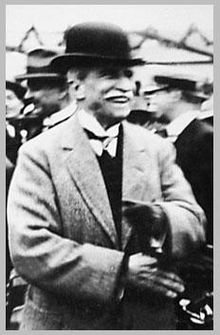Augusto B. Leguía y Salcedo
| Augusto B. Leguía | |
|---|---|

Leguía at a horse racing event. (1924)
|
|
| 65th President of Peru | |
|
In office September 24, 1908 – September 24, 1912 |
|
| Preceded by | José Pardo |
| Succeeded by | Guillermo Billinghurst |
| 69th President of Peru | |
|
In office July 4, 1919 – August 25, 1930 |
|
| Preceded by | José Pardo |
| Succeeded by | Manuel Ponce |
| Prime Minister of Peru | |
|
In office September 24, 1904 – August 1, 1907 |
|
| President | José Pardo y Barreda |
| Preceded by | Jorge Prado y Ugarteche |
| Succeeded by | Alberto Rey de Castro y Romaña |
| Personal details | |
| Born |
Augusto Bernardino Leguía y Salcedo February 19, 1863 Lambayeque, Peru |
| Died | February 7, 1932 (aged 68) Callao, Peru |
| Political party |
Civilista Party (until 1920) Reformist Democratic Party (1920-1932) |
| Profession | Economist |
Augusto Bernardino Leguía y Salcedo (February 19, 1863 – February 7, 1932) was a Peruvian politician who twice served as President of Peru, from 1908 to 1912 and from 1919 to 1930.
Augusto Leguía was born in Lambayeque in 1863, and later married into one of the most distinguished families of the Peruvian oligarchy. Educated in Valparaíso, Chile, he served in the Peruvian Army during the War of the Pacific (1879–1881).
After the war he moved to the United States and became an insurance executive with the New York Life Insurance Company. By the 1900s, Leguía had become very wealthy and decided to return to Peru. He entered politics in 1903 at the urging of Manuel Candamo (the then leader of the Civilista Party) and also of José Pardo, who was Prime Minister. Leguía took the position of Minister of Finance, a post he would retain until 1904, when the former Prime Minister José Pardo became president. Pardo offered the position of Prime Minister to Leguía, who accepted and remained so until 1907, when he resigned to run for the presidency the following year.
In 1908 he succeeded José Pardo (a succession event that would occur again in 1919) after being elected president for the first time by an alliance of the Civil and Constitutional parties. Some of Leguía's first actions were to institute social and economic reforms in an attempt to industrialize Peru and turn it into a modern capitalist society.
On May 29, 1909, a group of citizens (supporters of Piérola's Democratic Party) managed to force their entry into the Palacio de Gobierno demanding the resignation of Leguía. Among the group were the brother and sons of Piérola; Carlos de Piérola, Isaías de Piérola and Amadeo de Piérola. Since Leguía did not resign as planned, they kidnapped him and took him in front of the Bolivar Monument (located in Plaza inquisicion in Lima). Once there, Leguía did not acquiesce to their demands, and the police had to forcibly rescue the president in the midst of a fight that caused at least 100 deaths.
...
Wikipedia
